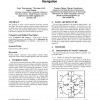Free Online Productivity Tools
i2Speak
i2Symbol
i2OCR
iTex2Img
iWeb2Print
iWeb2Shot
i2Type
iPdf2Split
iPdf2Merge
i2Bopomofo
i2Arabic
i2Style
i2Image
i2PDF
iLatex2Rtf
Sci2ools
ASSETS
2008
ACM
2008
ACM
Brain-controlled finite state machine for wheelchair navigation
This proposal is about a brain-controlled electrically powered wheelchair. The system comprises a brain-computer interface based on steady-state visual evoked potentials and a processing unit relying on a finite state machine (FSM). Results of first simulation experiments comparing two different FSMs are presented. Categories and Subject Descriptors K.4.2 [Computers and Society]: Social Issues--Assistive technologies for persons with disabilities; H.5.2 [Information Interfaces and Presentation]: User Interfaces--Input devices and strategies General Terms Experimentation, Human Factors Keywords Human-computer interaction, brain-computer interface (BCI), steady-state visual evoked potentials (SSVEP), finite state machine
ASSETS 2008 | Brain-computer Interface | Emerging Technology | Finite State Machine | Visual Evoked Potentials |
| Added | 12 Oct 2010 |
| Updated | 12 Oct 2010 |
| Type | Conference |
| Year | 2008 |
| Where | ASSETS |
| Authors | Amir Teymourian, Thorsten Lüth, Axel Graeser, Torsten Felzer, Rainer Nordmann |
Comments (0)

